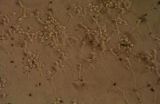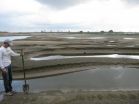(Press-News.org) (PHILADELPHIA) -- Muscle weakness is a common symptom of both long-time alcoholics and patients with mitochondrial disease. Now researchers have found a common link: mitochondria that are unable to self-repair. The results will be published online April 21 in The Journal of Cell Biology. The link to self-repair provides researchers both a new way to diagnose mitochondrial disease, and a new drug target.
Mitochondria -- organelles that produce the energy needed for muscle, brain, and every other cell in the body -- repair their broken components by fusing with other mitochondria and exchanging their contents. Damaged parts are segregated for recycling and replaced with properly functioning proteins donated from healthy mitochondria.
While fusion is one major method for mitochondrial quality control in many types of cells, researchers have puzzled over the repair mechanism in skeletal muscle -- a type of tissue that relies constantly on mitochondria for power, making repair a frequent necessity. However, mitochondria are squeezed so tightly in between the packed fibers of muscle cells, that most researchers assumed that fusion among mitochondria in this tissue type was impossible.
An inkling that fusion might be important for the normal muscle function came from research on two mitochondrial diseases: Autosomal Dominant Optical Atropy (ADOA) disease, and a type of Charcot-Marie-Tooth disease (CMT). A symptom of both disease is muscle weakness and patients with both these diseases carry a mutation in one of the three genes involved in mitochondrial fusion.
To investigate whether mitochondria in the muscle could indeed fuse to regenerate, first author Veronica Eisner, Ph.D., a postdoctoral fellow at Thomas Jefferson University created a system to tag the mitochondria in skeletal muscle of rats with two different colors and then watch if they mingled. First, she created a rat model whose mitochondria expressed the color red at all times. She also genetically engineered the mitochondria in the cells to turn green when zapped with a laser, creating squares of green-shining mitochondria within the red background. To her surprise, the green mitochondria not only mingled with the red, exchanging contents, but were also able to travel to other areas where only red-colored mitochondria had been. The results were exciting in that they showed "for the first time that mitochondrial fusion occurs in muscle cells," says Dr. Eisner.
The researcher team, led by Dr. Gyorgy Hajnoczky, M.D., Ph.D., Director of Jefferson's MitoCare Center and professor in the department of Pathology, Anatomy & Cell Biology, then showed that of the mitofusin (Mfn) fusion proteins, Mfn1 was most important in skeletal muscle cells.
Once they had identified Mfn1, they were able to test whether mitochondrial fusion was the culprit in other examples of muscle weakness, such as alcoholism. One long-term symptom of alcoholism is the loss of muscle strength. The researchers showed that the Mfn1 abundance went down as much as 50 percent in rats on a regular alcohol diet-while other fusion proteins were unchanged, and that this decrease was coupled with a massive decrease in mitochondrial fusion. When Mfn1 was restored, so was the mitochondrial fusion. They also linked the decreased Mfn1 and mitochondrial fusion to increased muscle fatigue.
"That alcohol can have a specific effect on this one gene involved in mitochondrial fusion suggests that other environmental factors may also specifically alter mitochondrial fusion and repair," says Dr. Hajnoczky.
"The work provides more evidence to support the concept that fission and fusion -- or mitochondrial dynamics -- may be responsible for more than just a subset of mitochondrial diseases we know of," says Dr. Hajnoczky. "In addition, knowing the proteins involved in the process gives us the possibility of developing a drug."
INFORMATION:
This work was supported by PEW Latin American Fellows Program in the Biomedical Sciences and the Duchenne Parent Project, Netherlands fellowships to Veronika Eisner and by a grant from NIAAA (AA017773) to Gyorgy Hajnoczky.
The authors declare that they have no conflict of interest.
For more information, contact Edyta Zielinska, (215) 955-5291, edyta.zielinska@jefferson.edu.
About Jefferson
Thomas Jefferson University (TJU), the largest freestanding academic medical center in Philadelphia, is nationally renowned for medical and health sciences education and innovative research. Founded in 1824, TJU includes Jefferson Medical College (JMC), one of the largest private medical schools in the country and ranked among the nation's best medical schools by U.S. News & World Report, and the Jefferson Schools of Nursing, Pharmacy, Health Professions, Population Health and the Graduate School of Biomedical Sciences. Jefferson University Physicians is TJU's multi-specialty physician practice consisting of the full-time faculty of JMC. Thomas Jefferson University partners with its clinical affiliate, Thomas Jefferson University Hospitals.
Article reference: V. Eisner et al., "Mitochondrial fusion is frequent in skeletal muscle and supports excitation contraction coupling," Journal of Cell Biology, DOI:10.1083/jcb.201312066, 2014
Why alcoholism saps muscle strength
Mitochondrial repair may be to blame for muscle weakness in mitochondrial diseases and in long-time alcoholics
2014-04-21
ELSE PRESS RELEASES FROM THIS DATE:
Amino-functionalized carbon nanotubes act as a carrier for nerve growth factor
2014-04-21
In recent years, there are growing studies concerning the use of different carrier materials for sustained-release and controlled-release of nerve growth factor in neuroscience research. In a study by Prof. Gao Li and team from Tongji Medical College, Huazhong University of Science and Technology in China, amino-functionalized ethylenediamine-treated multi-walled carbon nanotubes were used to prepare carbon nanotubes-nerve growth factor complexes by non-covalent grafting. Results showed that amino functionalization improved carbon nanotubes-nerve growth factor complex dispersibility, ...
People selectively remember the details of atrocities that absolve in-group members
2014-04-21
Conversations about wartime atrocities often omit certain details. According to research published in Psychological Science, a journal of the Association for Psychological Science, these omissions can lead people to have different memories for the event depending on social group membership.
"We started thinking about this project around the time when stories began to emerge in the popular media about atrocities committed by American soldiers in Iraq and Afghanistan," says lead researcher Alin Coman, psychological scientist at Princeton University.
"We wanted to scientifically ...
A new key to unlocking the mysteries of physics? Quantum turbulence
2014-04-21
The recent discovery of the Higgs boson has confirmed theories about the origin of mass and, with it, offered the potential to explain other scientific mysteries.
But, scientists are continually studying other, less-understood forces that may also shed light on matters not yet uncovered. Among these is quantum turbulence, writes Katepalli Sreenivasan, an NYU University Professor, in a special issue of Proceedings of the National Academy of Sciences.
Sreenivasan's introductory analysis, written with issue co-editors Carlo Barenghi of Newcastle University and Ladislav ...
Mental illness not usually linked to crime, research finds
2014-04-21
WASHINGTON — In a study of crimes committed by people with serious mental disorders, only 7.5 percent were directly related to symptoms of mental illness, according to new research published by the American Psychological Association.
Researchers analyzed 429 crimes committed by 143 offenders with three major types of mental illness and found that 3 percent of their crimes were directly related to symptoms of major depression, 4 percent to symptoms of schizophrenia disorders and 10 percent to symptoms of bipolar disorder.
"When we hear about crimes committed by people ...
Teachers' scare tactics may lead to lower exam scores
2014-04-21
WASHINGTON -- As the school year winds down and final exams loom, teachers may want to avoid reminding students of the bad consequences of failing a test because doing so could lead to lower scores, according to new research published by APA.
"Teachers are desperately keen to motivate their students in the best possible way but may not be aware of how messages they communicate to students around the importance of performing well in exams can be interpreted in different ways," said lead author David Putwain, PhD, of Edge Hill University in Lancashire, England.
The study, ...
Ginseng can treat and prevent influenza and RSV, researcher finds
2014-04-21
ATLANTA--Ginseng can help treat and prevent influenza and respiratory syncytial virus (RSV), a respiratory virus that infects the lungs and breathing passages, according to research findings by a scientist in Georgia State University's new Institute for Biomedical Sciences.
In a recent issue of Nutrients and an upcoming publication of the International Journal of Molecular Medicine, Sang-Moo Kang reports the beneficial effects of ginseng, a well-known herbal medicine, on human health.
Kang's primary research focuses on designing and developing effective vaccines against ...
New material coating technology mimics nature's lotus effect
2014-04-21
VIDEO:
This movie explains the new coating material.
Click here for more information.
Ever stop to consider why lotus plant leaves always look clean? The hydrophobic – water repelling – characteristic of the leaf, termed the "Lotus effect," helps the plant survive in muddy swamps, repelling dirt and producing beautiful flowers.
Of late, engineers have been paying more and more attention to nature's efficiencies, such as the Lotus effect, and studying its behavior in order ...
Birthplace of the domesticated chili pepper identified in Mexico
2014-04-21
Central-east Mexico gave birth to the domesticated chili pepper — now the world's most widely grown spice crop — reports an international team of researchers, led by a plant scientist at the University of California, Davis.
Results from the four-pronged investigation — based on linguistic and ecological evidence as well as the more traditional archaeological and genetic data — suggest a regional, rather than a geographically specific, birthplace for the domesticated chili pepper. That region, extending from southern Puebla and northern Oaxaca to southeastern Veracruz, ...
Study: Centuries of sand to grow Mississippi Delta
2014-04-21
The wetlands of the Mississippi River Delta are slowly sinking and rapidly eroding, but new research from Rice University and the University of South Carolina has found the river's supply of sand -- the material engineers most need to rebuild the delta -- will stay constant for centuries.
The new study, which appears online this week in Nature Geoscience, is encouraging news for scientists and government officials who are working to shore up southeastern Louisiana's rapidly disappearing wetlands. The delta sinks each year as its soil settles and becomes more compact. ...
A protein required for integrity of induced pluripotent stem cells
2014-04-21
Cell reprogramming converts specialised cells such as nerve cells or skin cells towards an embryonic stem cell state. This reversal in the evolutionary development of cells also requires a reversal in the biology of telomeres, the structures that protect the ends of chromosomes; whilst under normal conditions telomeres shorten over time, during cell reprogramming they follow the opposite strategy and increase in length.
A study published today in the journal Stem Cell Reports, from the Cell Publishing Group, reveals that the SIRT1 protein is needed to lengthen and maintain ...
LAST 30 PRESS RELEASES:
Decoupling the HOR enhancement on PtRu: Dynamically matching interfacial water to reaction coordinates
Sulfur isn’t poisonous when it synergistically acts with phosphine in olefins hydroformylation
URI researchers uncover molecular mechanisms behind speciation in corals
Chitin based carbon aerogel offers a cleaner way to store thermal energy
Tracing hidden sources of nitrate pollution in rapidly changing rural urban landscapes
Viruses on plastic pollution may quietly accelerate the spread of antibiotic resistance
Three UH Rainbow Babies & Children’s faculty elected to prestigious American Pediatric Society
Tunnel resilience models unveiled to aid post-earthquake recovery
Satellite communication systems: the future of 5G/6G connectivity
Space computing power networks: a new frontier for satellite technologies
Experiments advance potential of protein that makes hydrogen sulfide as a therapeutic target for Alzheimer’s disease
Examining private equity’s role in fertility care
Current Molecular Pharmacology achieves a landmark: real-time CiteScore advances to 7.2
Skeletal muscle epigenetic clocks developed using postmortem tissue from an Asian population
Estimating unemployment rates with social media data
Climate policies can backfire by eroding “green” values, study finds
Too much screen time too soon? A*STAR study links infant screen exposure to brain changes and teen anxiety
Global psychiatry mourns Professor Dan Stein, visionary who transformed mental health science across Africa and beyond
KIST develops eco-friendly palladium recovery technology to safeguard resource security
Statins significantly reduce mortality risk for adults with diabetes, regardless of cardiovascular risk
Brain immune cells may drive more damage in females than males with Alzheimer’s
Evidence-based recommendations empower clinicians to manage epilepsy in pregnancy
Fungus turns bark beetles’ defenses against them
There are new antivirals being tested for herpesviruses. Scientists now know how they work
CDI scientist, colleagues author review of global burden of fungus Candida auris
How does stroke influence speech comprehension?
B cells transiently unlock their plasticity, risking lymphoma development
Advanced AI dodel predicts spoken language outcomes in deaf children after cochlear implants
Multimodal imaging-based cerebral blood flow prediction model development in simulated microgravity
Accelerated streaming subgraph matching framework is faster, more robust, and scalable
[Press-News.org] Why alcoholism saps muscle strengthMitochondrial repair may be to blame for muscle weakness in mitochondrial diseases and in long-time alcoholics



